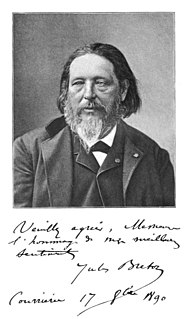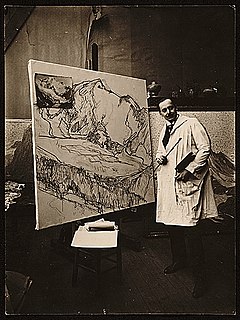
Edwin Austin Abbey was an American muralist, illustrator, and painter. He flourished at the beginning of what is now referred to as the "golden age" of illustration, and is best known for his drawings and paintings of Shakespearean and Victorian subjects, as well as for his painting of Edward VII's coronation. His most famous set of murals, The Quest and Achievement of the Holy Grail, adorns the Boston Public Library.

Jules Adolphe Aimé Louis Breton was a 19th-century French Naturalist painter. His paintings are heavily influenced by the French countryside and his absorption of traditional methods of painting helped make Jules Breton one of the primary transmitters of the beauty and idyllic vision of rural existence.

Charles Herbert Woodbury, United States marine painter, was born in Lynn, Massachusetts.

Edgar Alwin Payne was an American painter. He was known as a Western landscape painter and muralist.

Thomas Webster, was a British painter of genre scenes of school and village life, many of which became popular through prints. He lived for many years at the artists' colony at Cranbrook in Kent.

George Fuller was an American figure and portrait painter.

Frank Weston Benson, frequently referred to as Frank W. Benson, was an American artist from Salem, Massachusetts known for his Realistic portraits, American Impressionist paintings, watercolors and etchings. He began his career painting portraits of distinguished families and murals for the Library of Congress. Some of his best known paintings depict his daughters outdoors at Benson's summer home, Wooster Farm, on the island of North Haven, Maine. He also produced numerous oil, wash and watercolor paintings and etchings of wildfowl and landscapes.

Soren Emil Carlsen was an American Impressionist painter who emigrated to the United States from Denmark. He became known for his still lifes. Later in his career, Carlsen expanded his range of subjects to include landscapes and marines as well.

Thomas Francis Dicksee (1819–1895) was an English painter. He was a portraitist and painter of historical, genre subjects often inspired by the works of Shakespeare.

Albert Henry Krehbiel, was the most decorated American painter ever at the French Academy, winning the Prix De Rome, four gold medals and five cash prizes. He was born in Denmark, Iowa and taught, lived and worked for many years in Chicago. His masterpiece is the programme of eleven decorative wall and two ceiling paintings / murals for the Supreme and Appellate Court Rooms in Springfield, Illinois (1907-1911). Although educated as a realist in Paris, which is reflected in his neoclassical mural works, he is most famously known as an American Impressionist. Later in his career, Krehbiel experimented in a more modernist manner.

Alfred Thompson Bricher was a painter associated with White Mountain art and the Hudson River School.
Mervyn "Skip" Williamson was an American underground cartoonist and central figure in the underground comix movement. Williamson's art was published in the National Lampoon, High Times, the Realist, the Industrial Worker, the Chicago Seed, Encyclopædia Britannica and others. His best-known character is Snappy Sammy Smoot.

Susan Hannah Macdowell Eakins was an American painter and photographer. Her works were first shown at the Pennsylvania Academy of Fine Arts, where she was a student. She won the Mary Smith Prize there in 1879 and the Charles Toppan prize in 1882. One of her teachers was the artist Thomas Eakins, who later became her husband. She made portrait and still life paintings. She was also known for her photography. After her husband died in 1916, Eakins became a prolific painter. Her works were exhibited in group exhibitions in her lifetime, though her first solo exhibition was held after she died.

Henry Wyndham Phillips was a British artist and portrait painter. Although he produced and exhibited a small number of paintings of scriptural subjects early on in his career, he spent most of his life working as a portrait artist. He was born in London, the younger son of the portraitist Thomas Phillips, from whom he received most of his art tuition. When his father died in 1845, he bequeathed Henry all of his painting materials and the use of his painting rooms at 8, George Street, Hanover Square in central London, where Henry is believed to have lived for the rest of his life.

Henry Herbert La Thangue was an English realist rural landscape painter associated with the Newlyn School.

Paul Hampden Dougherty was an American marine painter. Dougherty was recognized for his American Impressionism paintings of the coasts of Maine and Cornwall in the years after the turn of the 20th century. His work has been described as bold and masculine, and he was best known for his many paintings of breakers crashing against rocky coasts and mountain landscapes. Dougherty also painted still lifes, created prints and sculpted.

Greg Constantine is a contemporary Canadian-American artist who currently lives and works in Berrien Springs, Michigan.

Louis Frederick Grell was an American figure composition and portrait artist based in the Tree Studio resident artist colony in Chicago, Illinois, USA. He received his formal training in Europe from 1900 through 1915 and later became art professor at the Chicago Academy of Fine Arts from 1916 to 1922, and at the Art Institute of Chicago from 1922 to 1934. Grell exhibited his works throughout Europe from 1905 to 1915, in San Francisco in 1907, and in Chicago at the Art Institute 25 times from 1917 to 1941. He exhibited in New York in 1915 and 1916 and in Philadelphia and Washington DC. Primarily an allegorical and figurative composition muralist and portrait painter, his creative strokes adorn the ceilings and walls of numerous US National Historic Landmark buildings.

Hugh Bolton Jones was an American landscape painter. He grew up in Baltimore, Maryland, where he received his early training as an artist. While studying in New York he was strongly influenced by Frederic Edwin Church of the Hudson River School. After spending four years in Europe he settled in New York in 1881, where he shared a studio with his brother Francis Coates Jones for the rest of his long life. He was celebrated for his realistic depictions of calm rural scenes of the eastern United States at different times of the year, usually empty of people. He won prizes in several major exhibitions in the US and France. His paintings are held in public collections such as the Metropolitan Museum of Art and the Smithsonian Institution.

Joseph Decker was a German-born American painter who specialized in still-lifes. His subjects were mostly of edible, rather than man-made objects.




















